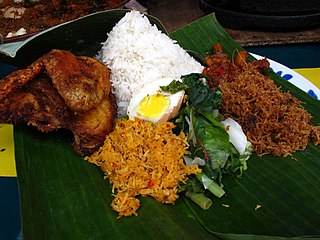Related Research Articles

Malaysian cuisine consists of cooking traditions and practices found in Malaysia, and reflects the multi-ethnic makeup of its population. The vast majority of Malaysia's population can roughly be divided among three major ethnic groups: Malays, Chinese and Indians. The remainder consists of the indigenous peoples of Sabah and Sarawak in East Malaysia, the Orang Asli of Peninsular Malaysia, the Peranakan and Eurasian creole communities, as well as a significant number of foreign workers and expatriates.

Nasi lemak is a dish originating in Malay cuisine that consists of fragrant rice cooked in coconut milk and pandan leaf. It is commonly found in Malaysia, where it is considered as the national dish. It is also a native dish in neighbouring areas with significant ethnic Malay populations such as Singapore and Southern Thailand. In Indonesia, it can be found in several parts of Sumatra, especially the Malay regions of Riau, Riau Islands and Medan. It is considered an essential dish for a typical Malay-style breakfast. Nasi lemak is featured as a national dish in Malaysian tourism brochures and promotional materials.

Hokkien mee, literally "Fujian noodles", is a series of related Southeast Asian dishes that have their origins in the cuisine of China's Fujian (Hokkien) province.

Malay Singaporeans are Singaporeans with general ancestry from the Malay world. They constitute approximately 13.5% of the country's citizens, making them the second largest ethnic group in Singapore. Under the Constitution of Singapore, they are recognised by the government as the indigenous people of the country, with Malay as the de jure national language of Singapore.

Singaporean cuisine is derived from several ethnic groups in Singapore and has developed through centuries of political, economic, and social changes in the cosmopolitan city-state.

A kopitiam or kopi tiam is a type of coffee shop mostly found in parts of Indonesia, Malaysia, Singapore, Brunei and Southern Thailand patronised for meals and beverages, and traditionally operated by the Chinese community of these countries. The word kopi is an Indonesian and Malay term for coffee and tiam is the Hokkien/Hakka term for shop. Traditional kopitiam menus typically feature simple offerings: a variety of foods based on egg, toast, kaya, plus coffee, tea, Horlicks and Milo. Modern kopitiams typically feature multiple food stalls that offer a wider range of foods.

Chilli crab is a Southeast Asian seafood dish that is widely associated with the cuisines of both Malaysia and Singapore. The widely known version of chili crab today could be traced back to the 1950s in Malaysia and Singapore. Mud crabs are commonly used and are stir-fried in a semi-thick, sweet, and savoury tomato-and-chilli-based sauce.

Fish head curry is a dish in Indonesian, Malaysian and Singaporean cuisines with mixed Indian and Chinese origins. The head of a red snapper is stewed in a Kerala-style curry with assorted vegetables such as okra and eggplants. It is usually served with either rice or bread, or as a shared dish.

Jumbo Seafood is a Singaporean restaurant chain specialising in the seafood aspects of Singaporean cuisine and dishes, such as Chili crab. First opened in 1987 with an outlet at the East Coast Seafood Centre modeling and taking design elements similar to the non affiliated JUMBO Floating Restaurant Hong Kong, Jumbo Kingdom. It became a hit, it then opened an additional five outlets throughout the country including in the suburban areas of Serangoon Gardens as well as the Singapore Indoor Stadium. As of 2022, it has 5 outlets in Singapore.

Mee goreng, or mi goreng, refers to fried noodles in the Malay-speaking cultures of several countries, such as the Southeast Asian states of Brunei, Malaysia, and Singapore.
Candlenut Kitchen, often known simply as Candlenut, is a Singaporean restaurant serving the local Peranakan cuisine. Located at the Tanglin district, the restaurant is owned by Malcolm Lee, who also serves as its executive chef.

Singaporeans are the citizens and nationals of the sovereign island city-state of Singapore. Singapore is home to a people of a variety of ethno-racial origins, with the city-state itself being a multi-racial, multi-cultural, multi-religious, and multi-lingual country. Singaporeans of Chinese, Malay, Indian and Eurasian descent have made up the overwhelming majority of the population since the 19th century. The Singaporean diaspora is also far-reaching worldwide.

Sambal stingray, also known as spicy banana leaf stingray and by the Malay name ikan bakar, is a Malaysian/Singaporean seafood dish. Prepared by barbecuing stingray, it is served with sambal paste atop. Sambal stingray can be easily purchased at hawker centers in both Malaysia and Singapore.

Nasi ambeng or Nasi ambang is an Indonesian fragrant rice dish that consists of—but is not limited to—steamed white rice, chicken curry or chicken stewed in soy sauce, beef or chicken rendang, sambal gorengurap, bergedel, and serunding.

Mamak stalls are indoor and open-air food establishments particularly found in Southeast Asia, especially in Malaysia, which serve a type of Indian Muslim cuisine unique to the region and by its Indian community.

Chua Jim Neo was a Singaporean chef and cookbook writer best known for Mrs. Lee's Cookbook, which preserves the recipes of Peranakan cuisine. Chua was also the mother of Lee Kuan Yew, the first Prime Minister of Singapore and the paternal grandmother of Lee Hsien Loong, the third Prime Minister of Singapore.
Bread Street Kitchen is a restaurant owned by celebrity chef and restaurateur Gordon Ramsay. Located in Singapore and modelled after the original Bread Street Kitchen in the United Kingdom, the restaurant was opened in June 2015.
Violet Oon is a Singaporean chef, restaurateur, and food writer known for her food columns, cookbooks, and restaurants specializing in Peranakan cuisine. She has been the food ambassador of Singapore since 1988.
Odette is a Singaporean restaurant. Founded in 2015 by chef Julien Royer in collaboration with the local Lo & Behold Group, Odette features a fusion of French cuisine with Asian influences, including of Singapore's.

Chatterbox is a restaurant located in Hilton Singapore Orchard. The restaurant opened on 1 August 1971 at The Mandarin Singapore and has since undergone several relocations and renovations. It is known for its Hainanese chicken rice, which was introduced to Chatterbox's first menu by German executive chef Peter Gehrmann.
References
- 1 2 3 4 5 6 7 8 9 10 11 12 13 14 15 16 17 18 Tan, Rebecca Lynne (6 May 2013). "Spice of life: Former restaurateur Aziza Ali is a busy woman". The Straits Times .(subscription required)
- 1 2 3 Ng, Sheere (27 March 2013). "Religion and Superstitions in the Dining Business". Archived from the original on 4 June 2013.
- 1 2 Lee, Jan (7 March 2013). "Chef Aziza Ali launches new book on learning to cook in her childhood days". The Straits Times.(subscription required)
- ↑ The Food of Singapore: Authentic Recipes from the Manhattan of the East. Tuttle Publishing. 1995. p. 17. ISBN 9789625930077.
- ↑ Erlanger, Steve (24 December 1989). "WHAT'S DOING IN: Singapore". The New York Times .
- ↑ Moore, Wendy (1998). Peninsular Malaysia and Singapore. Tuttle Publishing. p. 295. ISBN 9789625931791.
- ↑ Eveland, Jennifer (1998). Frommer's Singapore & Malaysia. Macmillan Travel. p. 116. ISBN 9780028620992.